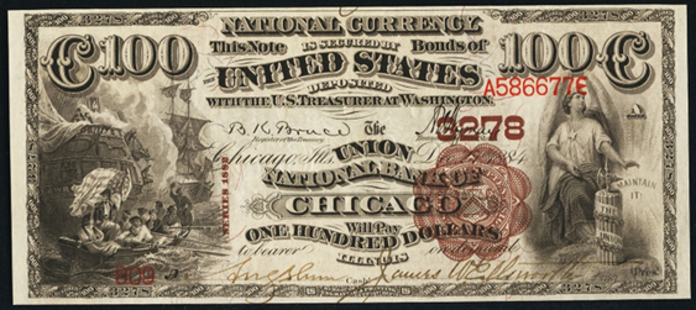One Hundred Dollar Notes › Nationals › 1882 One Hundred Dollar National Bank Notes › Pennsylvania Charters › 1882 $100 Erie Pennsylvania Keystone National Bank
Get Value Now
| Item | Info |
|---|---|
| Series | 1882 |
| Charter | #535 Keystone National Bank of Erie, Pennsylvania |
| Year Chartered | 1864, 503 Banks Chartered |
| City Info | Erie is a city in and the county seat of Erie County, Pennsylvania, United States. Named for the lake and the Native American tribe that resided along its southern shore, Erie is the fourth-largest city in Pennsylvania, as well as the largest city in Northwestern Pennsylvania., with a population of 101,786 at the 2010 census. The estimated population in 2016 had decreased to 100,055. The Erie metropolitan area, equivalent to all of Erie County, consists of 276,207 residents. The Erie-Meadville, PA Combined Statistical Area has a population of 369,331, as of the 2010 Census. Source: Wikipedia |
| Similar Cities | If your note doesn't match try: 1. Erie, Pennsylvania - First National Bank 2. Erie, Pennsylvania - Second National Bank 3. Erie, Pennsylvania - Marine National Bank 4. Erie, Kansas - First National Bank |
| Seal Varieties | Brown, Blue |
| See Also | If your note doesn't match try: 1. 1882 $100 Gold Certificate 2. 1878 $100 Legal Tender 3. 1880 $100 Legal Tender |
| Other Info | 1. Value depends on notes known for charter, condition and market demand. 2. Rare and highly desirable National Note. |
| Neat Fact | 1-5 Digit Charter number critical to note identification. It is Red, Blue, Black or rarely absent altogehter. It is printed over the note design. |
No Obligations Offers and Appraisals
Please submit a good photo or scan. It will be identified and evaluated. Understand there may be subtle differences between the image you see above and your note. Signatures, design, markings and note condition will determine the offer price. Notes in Uncirculated or better condition receive the best offers.
Appraisals can be estimated for wholesale and retail prices. Wholesale is what dealers typically pay. Retail is what a collector might pay. Retail is slightly higher in most cases.
Please visit this page for USA Paper Money Reference. Do not treat this page as a reference guide, it is for appraisal and acquisition purposes only.
